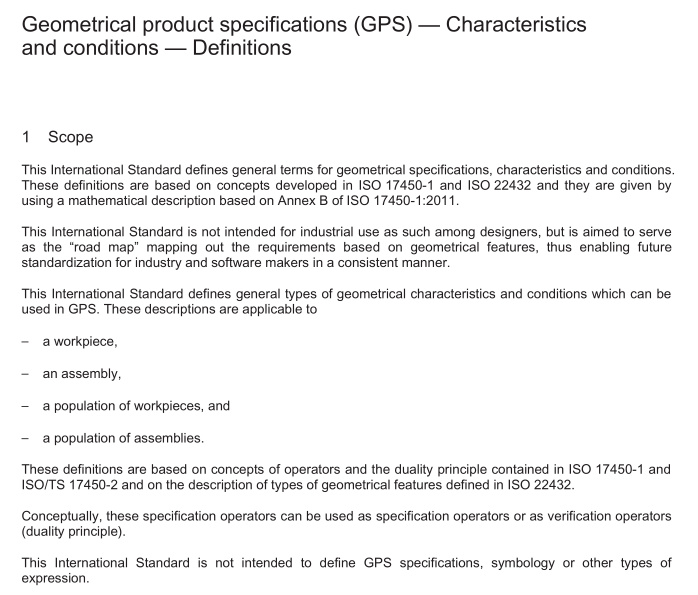BS EN ISO 25378 pdf download

BS EN ISO 25378 pdf download Geometrical product specifications (GPS) — Characteristics and conditions — Definitions
This International Standard defines general terms for geometrical specifications, characteristics and conditions.These definitions are based on concepts developed in ISO 17450-1 and ISO 22432 and they are given byusing a mathematical description based on Annex’B of lSO 17450-1:2011.
This International Standard is not intended for industrial use as such among designers, but is aimed to serveas the “road map”mapping out the requirements based on geometrical features,thus enabling futurestandardization for industry and software makers in a consistent manner.
This International Standard defines general types of geometrical characteristics and conditions which can beused in GPS.These descriptions are applicable to
– a workpiece,
– an assembly,
– a population of workpieces,and
-a population of assemblies.
These definitions are based on concepts of operators and the duality principle contained in ISO 17450-1 andISO/TS 17450-2 and on the description of types of geometrical features defined in ISO 22432.
Conceptually, these specification operators can be used as specification operators or as verification operators(duality principle).
This International Standard is not intended to define GPs specifications, symbology or other types ofexpression.
2Normative references
The following referenced documents are indispensable for the application of this document. For datedreferences,only the edition cited applies. For undated references,the latest edition of the referenceddocument (including any amendments) applies.
ISO 3534-1:2006,Statistics —Vocabulary and symbols —Part 1: General statistical terms and terms used inprobability
ISO 3534-2,Statistics – Vocabulary and symbols — Part 2: Applied statistics
ISO 17450-1:2011,Geometrical product specfications (GPs)— General concepts — Part 1: Model forgeometrical specification and verification
ISO/TS 17450-2,Geometrical product specifications (GPS)—General concepts — Part 2: Basic tenets,specifications, operators and uncertainties
ISO 224321),Geometrical product specifications(GPS)—Features utilized in specification and verification
3Terms and definitions
For the purposes of this document,the terms and definitions given in IS0 3534-1,ISO 3534-2 andISO 17450-1 and the following apply.
3.1
geometrical specification
expression of a set of one or more conditions on one or more geometrical characteristics
NOTE1 A specification can express a combination of individual conditions on an individual characteristic or apopulation condition on a population characteristic.
NOTE2 A specification consists of one or more single specifications.These single specifications can be individualspecifications, population specifications or any combination.
3.2
condition
combination of a limit value and a binary relational mathematical operator
EXAMPLE1″“be less than or equal to 6,3 , the expression of this condition can be, for instance:6,3 max or U 6,3.Mathematically: let X be the considered value of the characteristic, the condition is X u 6,3.
EXAMPLE2“be greater than or equal to 0,8 , the expression of this condition can be, for instance: 0,8 min or L 0,8.Mathematically: let X be the considered value of the characteristic, the condition is 0,8 uX.
EXAMPLE3 a set of two complementary conditions (lower and upper limits) can be expressed through, for instance:10,2-9,8,9,8+0,4,10 ±0,2, or 9.g 0,3
+0,1
-. Mathematically: let X be the considered value of the characteristic, the condition
is 9,8uxu 10,2.
EXAMPLE4 “be less than or equal to R,R being given by a function, R=(X2 +Y 2)×0,85, X and Y being the ordinatesof the coordinate system.
NOTE1 A binary relational mathematical operator is a mathematical concept which generalizes the notion as “greaterthan or equal to” in arithmetic, or “is item of the set” in set theory.
NOTE2 The limit value can be defined for any individual workpiece or for populations of workpieces.
NOTE3 The limit value can be independent of a coordinate system or dependent upon it. In the latter case, the limitvalue depends on the function of the ordinates of the coordinate system or graphical ordinate system.
NOTE4 The limit value can be determined by a statistical tolerancing approach, by an arithmetical tolerancing (worstcase) approach or by other means. The manner of determining the limit value and the choice of condition is not the subjectof this lnternational Standard.
NOTE 5 Two possible inequality relations exist:









